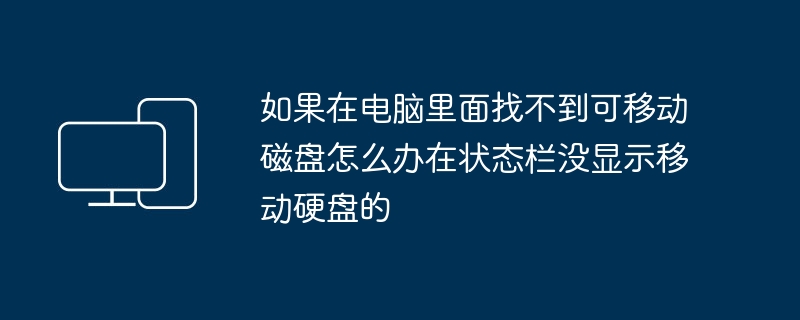

Step one: Click "Start", select "Run", enter "C:\WINDOWS\system32\systray.exe" in the run dialog box, and press Enter to execute the command. Then, try to plug and unplug the USB device again and observe whether the icon appears.
Step 2: If the "Safely Remove Hardware" icon cannot be reproduced, please perform the following operations. First, type "regedit" in the Run dialog box to open the Registry Editor. Next, expand the following branch: [HKEY_CURRENT_USER\Software\Microsoft\Windows\CurrentVersion\Run]. In the right pane, right-click the mouse and create a new string value, rename it "systray.exe". Then, double-click the string value and modify its numerical data to "C:\WINDOWS\system32\systray.exe", and finally confirm and exit the Registry Editor.
Step 3: Enter "devmgmt.msc" in the "Run" dialog box and press the Enter key to open the device manager. Look for the "Generic Flash USB Device" option under "Disk Drives". Although a USB flash drive is used as an example here, the actual application process may be different, but it is still easy to identify.
Step 4: Right-click the "Generic Flash USB Device" option and select "Properties" to open the properties window. In the Policies tab, select the Optimize for performance option instead of Optimize for fast deletion. Finally, click the "OK" button. After re-plugging the USB device, the "Safely Remove Hardware" icon should appear.
Step 5: If it still doesn’t work, you can reinstall the USB port driver. If you don’t know how to install it, then simply reinstall the motherboard driver. Although it is a little time-consuming, it is simple and convenient. After reinstalling the motherboard driver, the missing tray icon should be back.
Step 6: If the problem persists, you can try the following methods to fix it. First, open the run dialog box, enter "SFC /scannow" and press the Enter key. The system will start scanning and repairing system files. If prompted to insert the Windows installation CD, insert the installation CD into the CD-ROM drive. Once the repair is complete, restarting your computer should resolve the issue.
If it is useful, please click to adopt! !
Maybe the system cannot automatically assign the drive letter of the USB mobile hard disk!
Try the following method:
1. The solution is to right-click on "My Computer", find "Manage" from the context menu, open the "Computer Management" dialog box, find Disk Management in the tree menu, and then identify which partition is your active hard disk partition, assign it an unoccupied drive letter, and then you can see it in My Computer.
2. You can manually start the corresponding service (Removable Storage service). The specific method is: enter "services.msc" in the "Run" dialog box and press Enter, open the "Service Manager" window, find the "Removable Storage" service and Double-click and click the "Start" button in the dialog box that opens. (China Computer Education News)
3. Solution:
Start——>Run——>mountvol /e——>Enter——>Restart the machine
Attachment: Mountvol usage
Create, delete, or list mount points for volumes. Mountvol is a way to attach volumes without requiring a drive letter.
grammar
mountvol [Drive:]Path VolumeName
mountvol [Drive:]Path /d
mountvol [Drive:]Path /l
mountvol [Drive:]Path /p
mountvol /r
mountvol /n
mountvol /e
mountvol Drive:/s
parameter
[Drive:]Path
Specify the existing NTFS directory folder in which the mount point will reside.
VolumeName
Specify the volume name of the mount point target volume. The volume name structure is \\\\\\\\? \\\\Volume{GUID}\\\\, where {GUID} is a globally unique identifier (GUID) (for example, \\\\\\\\\?\\\\Volume\\\\{2eca078d-5cbc -43d3-aff8-7e8511f60d0e}\\\\).
/d
Delete the volume mount point from the specified folder.
/l
List the volume names mounted in the specified folder.
/p
Deletes the volume mount point from the specified directory, dismounts the basic volume, takes the basic volume offline, and makes it unmountable. If the volume is in use by other processes, mountvol will close all open handles before unmounting the volume. Volumes unmounted using /p will be listed in the volume list as NOT MOUNTED UNTIL A VOLUME MOUNT POINT IS CREATED. If the volume has more than one mount point, use /d to remove the other mount points before using /p. You can make a base volume remountable by assigning a volume mount point.
/r
Delete mount point directories and registry settings for volumes that no longer exist on the system. This will prevent volumes that were previously in the system from being automatically mounted, and prevent previous volume mount points from being granted when added back to the system.
/n
Disable automatic mounting of new basic volumes. New volumes are not automatically mounted when added to the system.
/e
Re-enable automatic mounting of new basic volumes.
/s
Restricted to Itanium-based computers. Mounts the EFI system partition on the specified drive.
/?
Show help in the command prompt.
Comments
If you run out of available drive letters, mount a local volume without a drive letter.
If you want to expand the volume space without reformatting or replacing the hard disk, you can add a mount path to another volume.
If you use a volume with multiple mount paths, the benefit is that you can use a single drive letter (such as C:) to access all local volumes. Although you can mount local volumes and assign them drive letters, you don't need to remember which volume corresponds to which drive letter.
The above is the detailed content of How to display the removable hard disk in the status bar when the removable disk cannot be found?. For more information, please follow other related articles on the PHP Chinese website!




